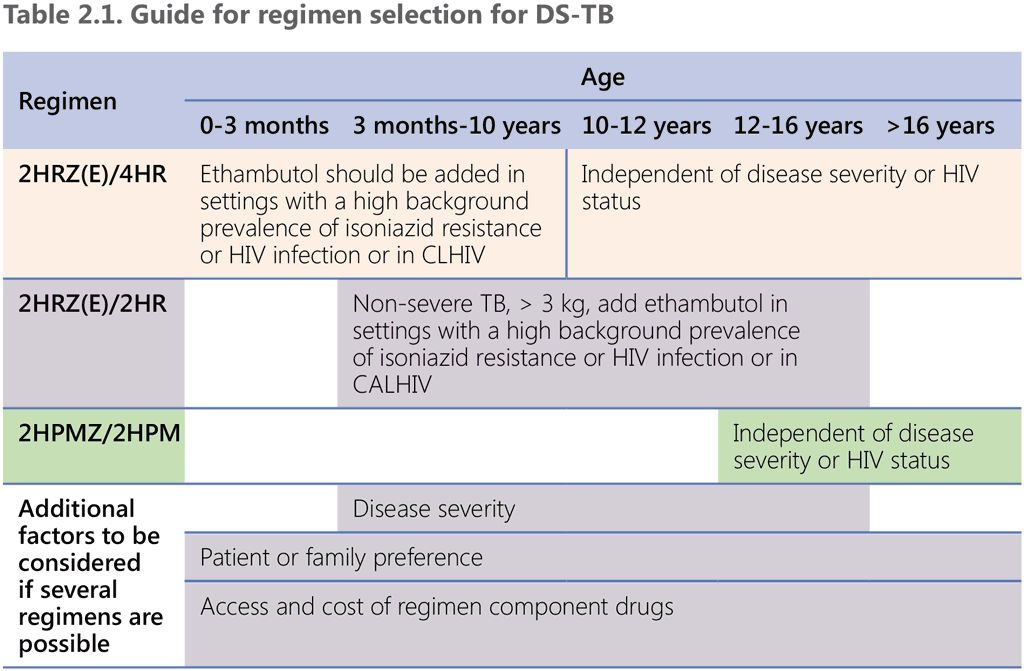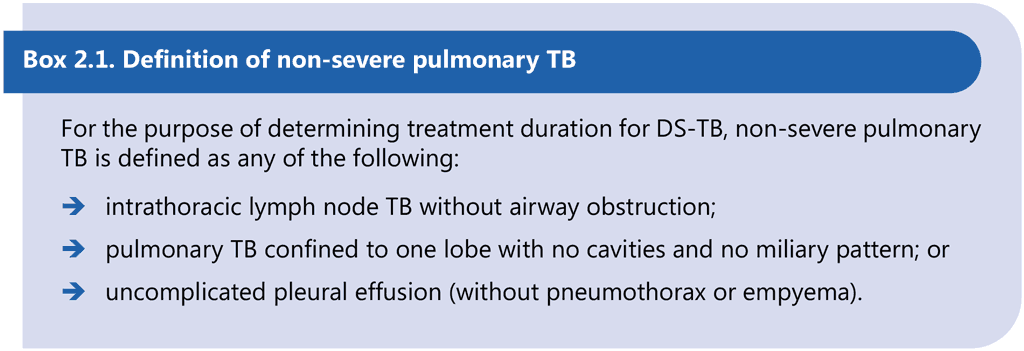Book traversal links for 2.3 Options in treatment of DS-TB
In patients with presumptive or confirmed DS-TB, there are several regimens that can be used based on current WHO policy. The 6-month regimen has become the standard of care all over the world but efforts have been made to develop effective shorter regimens to treat DS-TB. Several trials were designed to assess whether a shorter treatment regimen can remain highly effective and raise no additional safety concerns. Based on the results of recent randomized controlled trials (RCTs), WHO has recommended two different 4-month regimens: one based on the Study 31 trial¹⁰ and one based on the SHINE trial¹¹ (1).
Current recommendations cover regimens that differ in duration, composition and dosing of drug components. In addition, the eligible populations (depending on the available evidence) differ in terms of age and TB disease severity. The three recommended regimens are as follows:
- The 6-month regimen (2HRZ (E)/ 4 HR, described in Section 3) comprises 2 months of isoniazid, rifampicin, pyrazinamide (Z) and ethambutol (E), followed by 4 months of isoniazid and rifampicin. This regimen is recommended in all patient populations. In children (usually defined as being aged <10 years), the inclusion of ethambutol in the first 2 months of treatment is recommended in settings with a high prevalence of HIV,¹² in settings with isoniazid resistance or in children living with HIV (CLHIV), but can otherwise be omitted, resulting in the 2HRZ/4HR regimen (20).
- The 4-month regimen HPMZ (described in Section 4) comprises 2 months of isoniazid, rifapentine, moxifloxacin and pyrazinamide, followed by 2 months of rifapentine, isoniazid and moxifloxacin. This regimen is recommended for all those aged above 12 years, whatever the severity of TB disease.
- The 4-month regimen HRZ(E) (described in Section 5) comprises 2 months of isoniazid, rifampicin and pyrazinamide, with or without ethambutol, followed by isoniazid and rifampicin for 2 months for those aged between 3 months and 16 years, with non-severe pulmonary or peripheral lymph node TB. The use of ethambutol in the first 2 months of treatment is recommended in settings with a high prevalence of HIV, in settings with isoniazid resistance¹³ or in children and adolescents living with HIV (CALHIV).
Choice criteria for regimens in different age groups are summarized in Table 2.1.

CALHIV: children and adolescents living with HIV; CLHIV: children living with HIV; DS-TB: drug-susceptible TB; HIV: human immunodeficiency virus; TB: tuberculosis. Note: all the regimens envisage daily dosing of all medicines
As shown in Table 2.1, the age ranges presented in the current recommendations are as follows: from 3 months to 16 years for one 4-month regimen (for 2HRZ(E)/2HR regimen), 12 years and above for the other 4-month regimen (for 2HPMZ/2HPM regimen) and any age for the 6-month regimen (2HRZ(E)/4HR). There is some overlap between age groups; for example, several regimen options are available for the age range 3 months to 12 years (i.e. 2HRZ(E)/2HR and 2HRZ(E)/4HR) and for the age range 12–16 years (i.e. 2HRZ(E)/4HR, 2HPMZ/2HPM and 2HRZ(E)/2HR). The choice of regimen may also be influenced by clinical factors (e.g. severity of the disease, hepatic or renal failure, uncontrolled diabetes and HIV status), contextual factors (e.g. HIV or prevalence of isoniazid resistance) and access factors (e.g. availability of rifapentine and moxifloxacin, and cost of the regimen). For example, severity of TB disease (based on the definition of non-severe TB presented in Box 2.1) will determine the choice of the regimen for those aged between 3 months and 16 years.

All patients weighing more than 3 kg and aged between 3 months and 16 years, with non-severe TB based on the definition presented in Box 2.1, should be treated with the 4-month regimen 2HRZ(E)/2HR, with or without ethambutol. It is preferred that CLHIV who receive the 4-month regimen receive that regimen with ethambutol for the first 2 months of treatment, irrespective of the background prevalence of HIV. In addition, it is strongly recommended that ethambutol be added to the 4-month regimen for the first 2 months in settings with a high background prevalence of isoniazid resistance or HIV infection.
The 6-month regimen comprising 2HRZ(E)/4HR can be used in all patients in all age groups, independent of the disease severity and HIV status. However, in patients aged under 10 years, ethambutol can also be omitted in patients who are HIV-negative or in settings with a low prevalence of HIV and isoniazid resistance.
In patients with DS-TB aged 12 years or more, another possible treatment option is the regimen comprising 2HPMZ/2HPM. This regimen can be used in patients with both severe and non-severe forms of the disease, and in people living with HIV (People with HIV). Access, the pill burden and the cost of the HPMZ regimen may present barriers for implementation until rifapentine becomes more widely and readily available at costs comparable with rifampicin, and the fixed-dose combination (FDC) tablet is developed and becomes available. In some cases, patient and family preference may also guide the choice of the regimen if several regimen options apply to the patient once all other factors have been considered.
In summary, for treatment of DS-TB, WHO recommends either a 6-month regimen or, in specific subgroups of patients, either of two new 4-month regimens (as presented in Table 2.1).
In patients who require TB re-treatment, rapid DST should be performed to guide the regimen approach; that is, to determine whether the treatment should be for DS-TB or DR-TB. In 2017, the WHO Guideline Development Group (GDG) agreed to abolish the former Category II standard 8-month regimen (2HRZES/1HRZE/5HRE), which comprised an intensive phase of 3 months (2 months of isoniazid, rifampicin, pyrazinamide, ethambutol and streptomycin followed by 1 month without streptomycin), followed by a continuation phase of 5 months with isoniazid, rifampicin and ethambutol. The GDG put forward a good practice statement that this 8-month regimen should no longer be prescribed, and that DST should be conducted to inform the choice of the treatment regimen.
The three current regimen formulations and their durations are summarized below.
6-month regimen
New patients with pulmonary TB should receive a regimen containing rifampicin for 6 months. This 6-month treatment regimen, 2HRZ(E)/4HR, comprises isoniazid, rifampicin, pyrazinamide and ethambutol for 2 months followed by isoniazid and rifampicin for 4 months.
4-month regimens
Patients aged 12 years or more with pulmonary DS-TB may receive the 4-month regimen 2HPMZ/2HPM, which comprises rifapentine, isoniazid, pyrazinamide and moxifloxacin (2 months of isoniazid, rifapentine, moxifloxacin and pyrazinamide, followed by 2 months of isoniazid, rifapentine and moxifloxacin).
Children and adolescents aged between 3 months and 16 years with non-severe DS-TB should receive the 4-month regimen 2HRZ(E)/2HR, which comprises isoniazid, rifampicin and pyrazinamide, with or without ethambutol, for 2 months followed by isoniazid and rifampicin for 2 months.
Severe forms of TB such as tuberculous meningitis and osteoarticular TB may require additional clinical evaluation and judgement, and longer treatment regimens. Daily or weekly pyridoxine supplementation is suggested when giving isoniazid to patients with such forms of TB.
¹⁰ Study 31 is a Phase III trial: TBTC Study 31/ACTG A5349 (1), also referred to as S31/A5349.
¹¹ SHINE is the Shorter Treatment for Minimal Tuberculosis in Children trial, a large Phase III trial to evaluate duration of TB treatment in children with non-severe DS-TB
¹² Defined as countries, subnational administrative units or selected facilities, where the HIV prevalence among adult pregnant women is ≥1% or among TB patients is ≥5% (19).
¹³ WHO does not intend to establish thresholds for low, moderate or high levels of prevalence of isoniazid resistance; NTPs should establish definitions for their own countries.
 Feedback
Feedback